Analysis of Tourism and Sustainability Papers
VerifiedAdded on 2021/04/17
|13
|3856
|125
AI Summary
This assignment requires analyzing a list of 23 academic papers related to tourism and sustainability. The papers cover various topics such as destination development, climate change adaptation, sustainable tourism practices, and the impact of tourism on local communities. Students are expected to carefully examine each paper, identify key themes and concepts, and provide a detailed summary of the main findings. The assignment aims to develop critical thinking skills, attention to detail, and the ability to synthesize complex information from multiple sources.
Contribute Materials
Your contribution can guide someone’s learning journey. Share your
documents today.
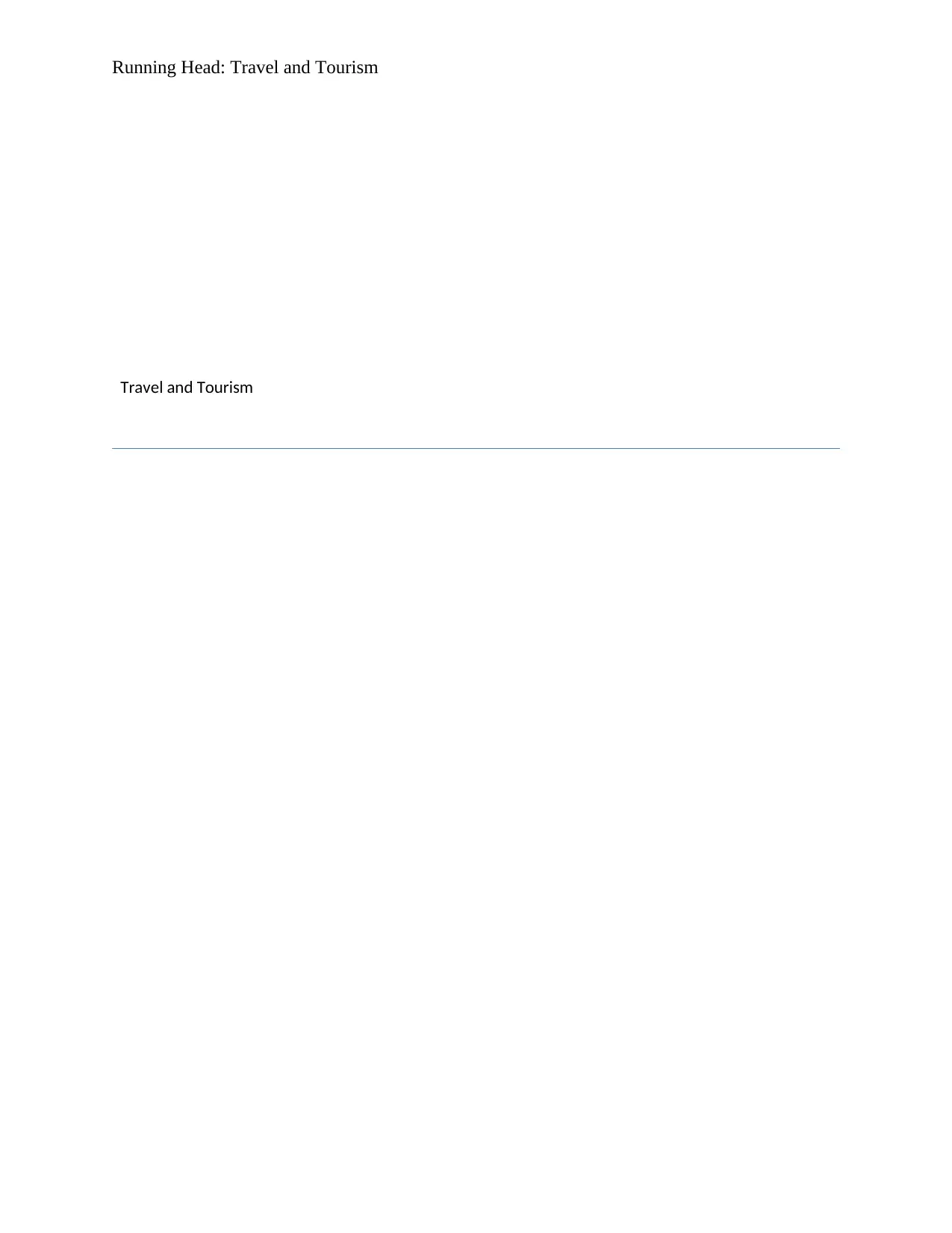
Running Head: Travel and Tourism
Travel and Tourism
Travel and Tourism
Secure Best Marks with AI Grader
Need help grading? Try our AI Grader for instant feedback on your assignments.
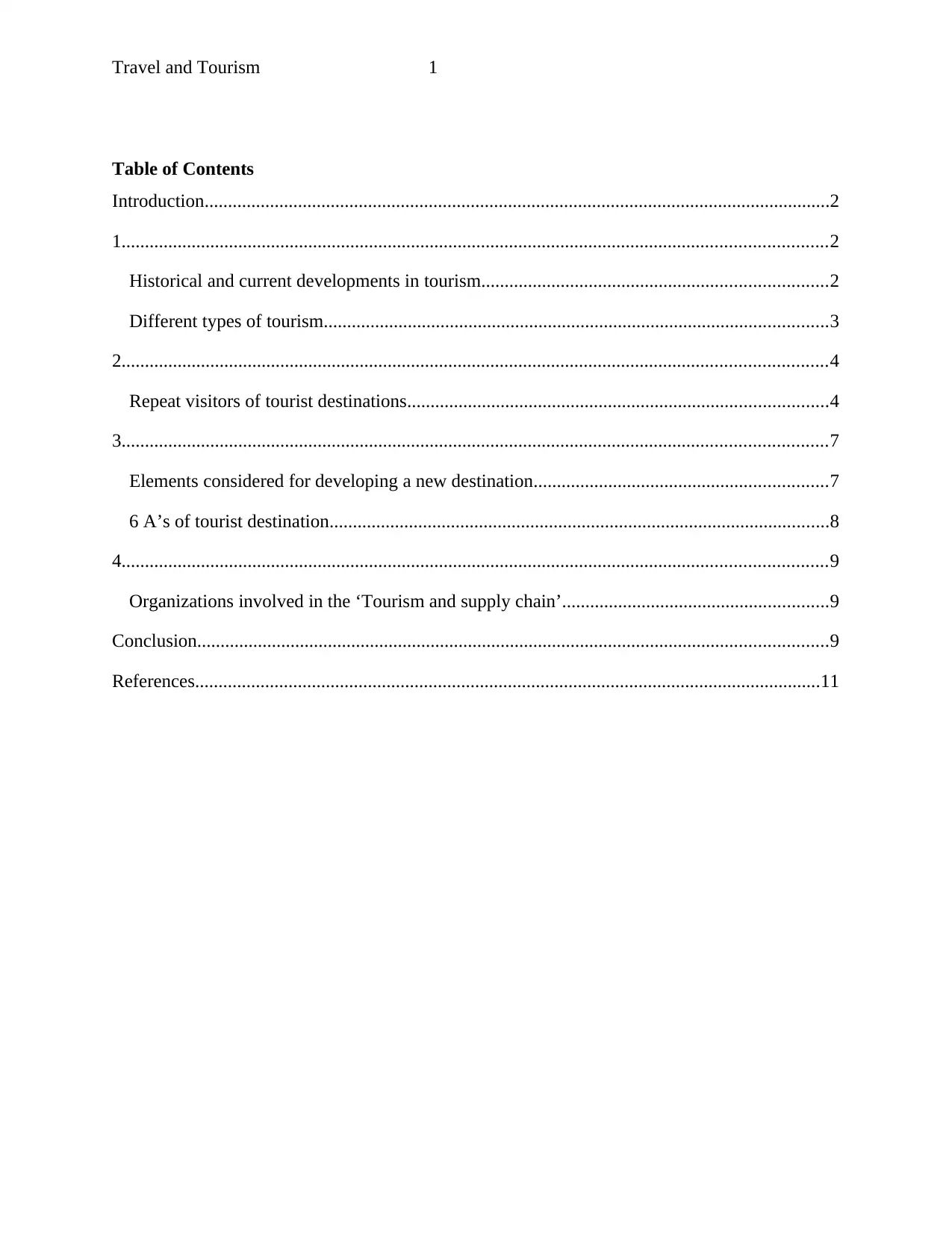
Travel and Tourism 1
Table of Contents
Introduction......................................................................................................................................2
1.......................................................................................................................................................2
Historical and current developments in tourism..........................................................................2
Different types of tourism............................................................................................................3
2.......................................................................................................................................................4
Repeat visitors of tourist destinations..........................................................................................4
3.......................................................................................................................................................7
Elements considered for developing a new destination...............................................................7
6 A’s of tourist destination...........................................................................................................8
4.......................................................................................................................................................9
Organizations involved in the ‘Tourism and supply chain’.........................................................9
Conclusion.......................................................................................................................................9
References......................................................................................................................................11
Table of Contents
Introduction......................................................................................................................................2
1.......................................................................................................................................................2
Historical and current developments in tourism..........................................................................2
Different types of tourism............................................................................................................3
2.......................................................................................................................................................4
Repeat visitors of tourist destinations..........................................................................................4
3.......................................................................................................................................................7
Elements considered for developing a new destination...............................................................7
6 A’s of tourist destination...........................................................................................................8
4.......................................................................................................................................................9
Organizations involved in the ‘Tourism and supply chain’.........................................................9
Conclusion.......................................................................................................................................9
References......................................................................................................................................11
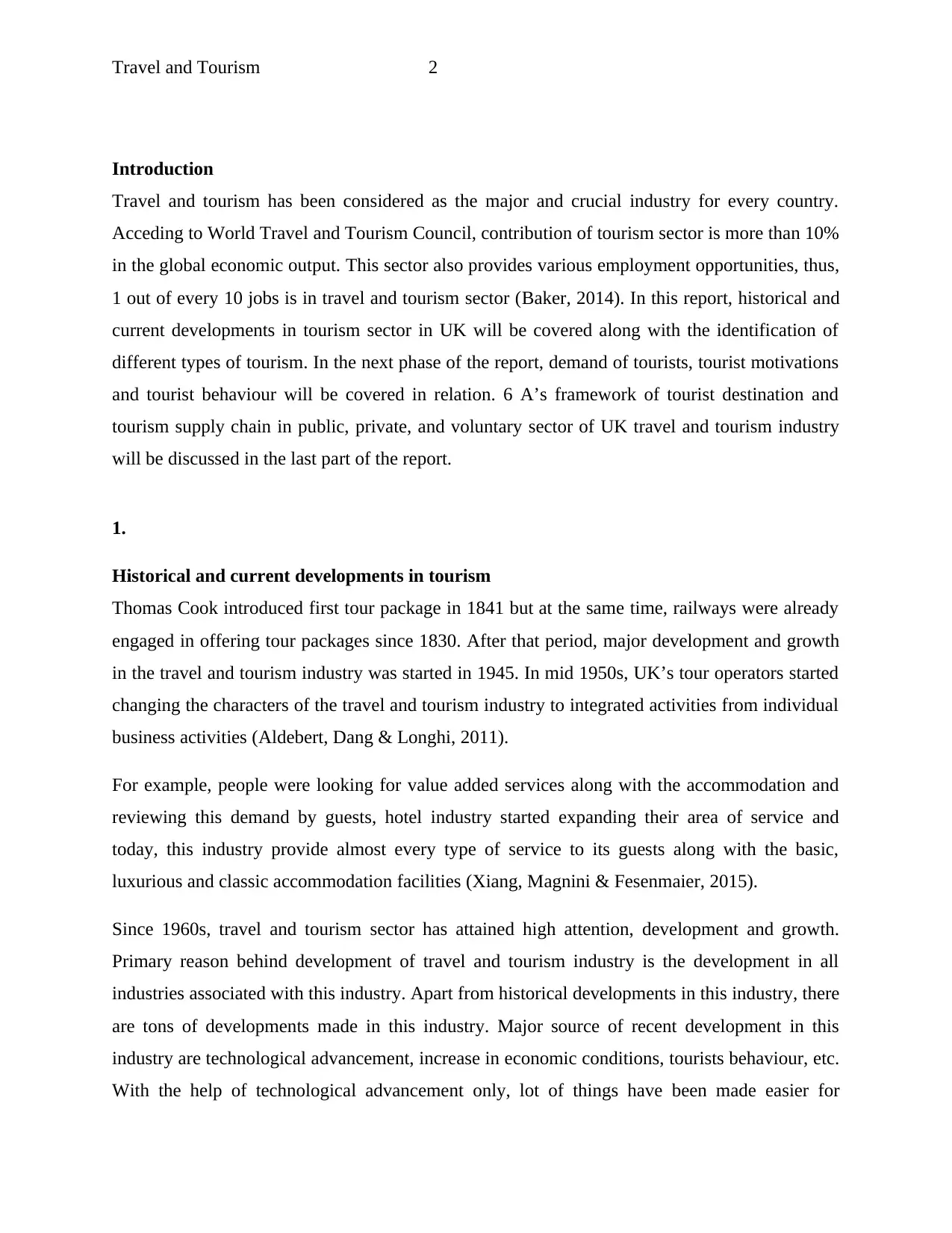
Travel and Tourism 2
Introduction
Travel and tourism has been considered as the major and crucial industry for every country.
Acceding to World Travel and Tourism Council, contribution of tourism sector is more than 10%
in the global economic output. This sector also provides various employment opportunities, thus,
1 out of every 10 jobs is in travel and tourism sector (Baker, 2014). In this report, historical and
current developments in tourism sector in UK will be covered along with the identification of
different types of tourism. In the next phase of the report, demand of tourists, tourist motivations
and tourist behaviour will be covered in relation. 6 A’s framework of tourist destination and
tourism supply chain in public, private, and voluntary sector of UK travel and tourism industry
will be discussed in the last part of the report.
1.
Historical and current developments in tourism
Thomas Cook introduced first tour package in 1841 but at the same time, railways were already
engaged in offering tour packages since 1830. After that period, major development and growth
in the travel and tourism industry was started in 1945. In mid 1950s, UK’s tour operators started
changing the characters of the travel and tourism industry to integrated activities from individual
business activities (Aldebert, Dang & Longhi, 2011).
For example, people were looking for value added services along with the accommodation and
reviewing this demand by guests, hotel industry started expanding their area of service and
today, this industry provide almost every type of service to its guests along with the basic,
luxurious and classic accommodation facilities (Xiang, Magnini & Fesenmaier, 2015).
Since 1960s, travel and tourism sector has attained high attention, development and growth.
Primary reason behind development of travel and tourism industry is the development in all
industries associated with this industry. Apart from historical developments in this industry, there
are tons of developments made in this industry. Major source of recent development in this
industry are technological advancement, increase in economic conditions, tourists behaviour, etc.
With the help of technological advancement only, lot of things have been made easier for
Introduction
Travel and tourism has been considered as the major and crucial industry for every country.
Acceding to World Travel and Tourism Council, contribution of tourism sector is more than 10%
in the global economic output. This sector also provides various employment opportunities, thus,
1 out of every 10 jobs is in travel and tourism sector (Baker, 2014). In this report, historical and
current developments in tourism sector in UK will be covered along with the identification of
different types of tourism. In the next phase of the report, demand of tourists, tourist motivations
and tourist behaviour will be covered in relation. 6 A’s framework of tourist destination and
tourism supply chain in public, private, and voluntary sector of UK travel and tourism industry
will be discussed in the last part of the report.
1.
Historical and current developments in tourism
Thomas Cook introduced first tour package in 1841 but at the same time, railways were already
engaged in offering tour packages since 1830. After that period, major development and growth
in the travel and tourism industry was started in 1945. In mid 1950s, UK’s tour operators started
changing the characters of the travel and tourism industry to integrated activities from individual
business activities (Aldebert, Dang & Longhi, 2011).
For example, people were looking for value added services along with the accommodation and
reviewing this demand by guests, hotel industry started expanding their area of service and
today, this industry provide almost every type of service to its guests along with the basic,
luxurious and classic accommodation facilities (Xiang, Magnini & Fesenmaier, 2015).
Since 1960s, travel and tourism sector has attained high attention, development and growth.
Primary reason behind development of travel and tourism industry is the development in all
industries associated with this industry. Apart from historical developments in this industry, there
are tons of developments made in this industry. Major source of recent development in this
industry are technological advancement, increase in economic conditions, tourists behaviour, etc.
With the help of technological advancement only, lot of things have been made easier for
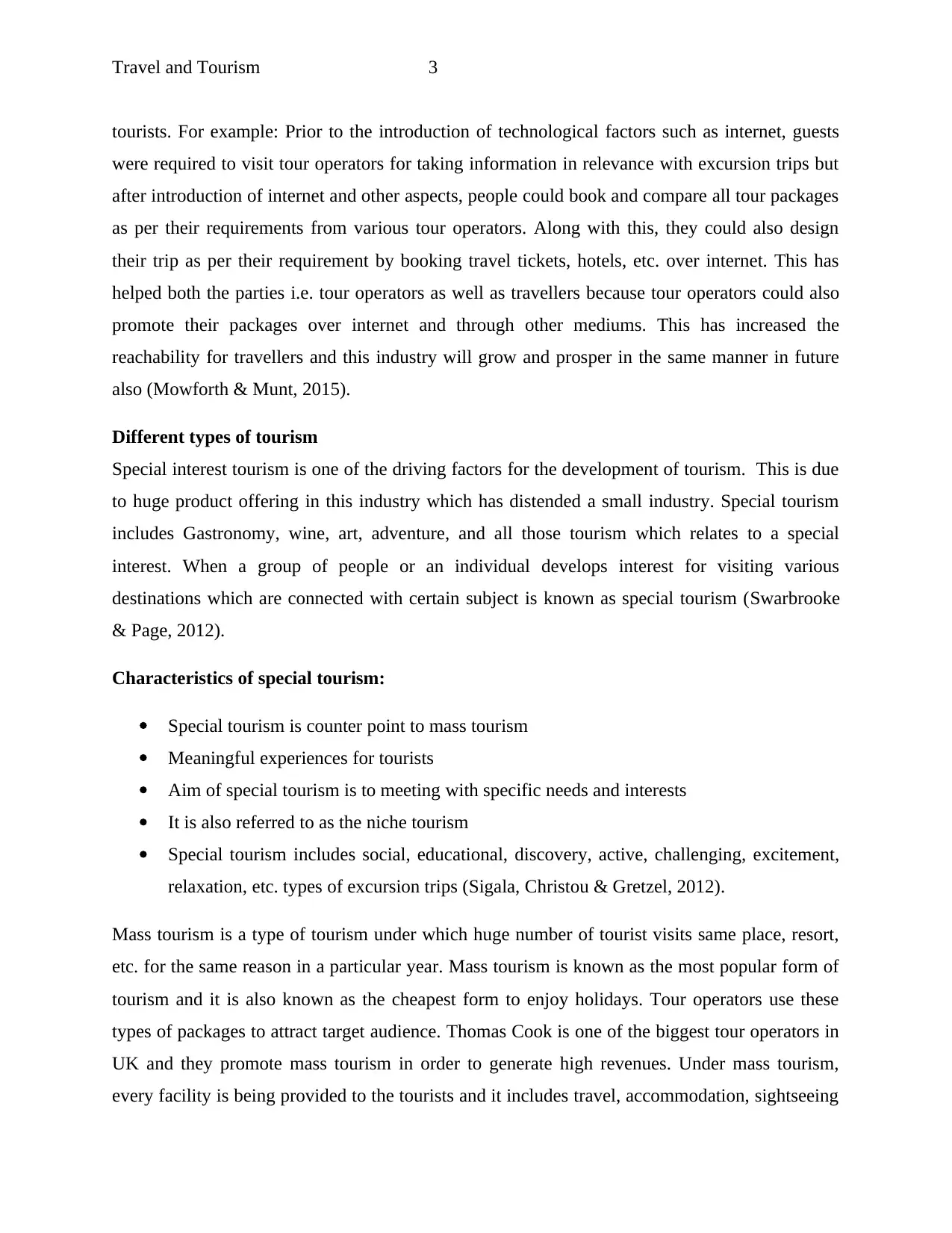
Travel and Tourism 3
tourists. For example: Prior to the introduction of technological factors such as internet, guests
were required to visit tour operators for taking information in relevance with excursion trips but
after introduction of internet and other aspects, people could book and compare all tour packages
as per their requirements from various tour operators. Along with this, they could also design
their trip as per their requirement by booking travel tickets, hotels, etc. over internet. This has
helped both the parties i.e. tour operators as well as travellers because tour operators could also
promote their packages over internet and through other mediums. This has increased the
reachability for travellers and this industry will grow and prosper in the same manner in future
also (Mowforth & Munt, 2015).
Different types of tourism
Special interest tourism is one of the driving factors for the development of tourism. This is due
to huge product offering in this industry which has distended a small industry. Special tourism
includes Gastronomy, wine, art, adventure, and all those tourism which relates to a special
interest. When a group of people or an individual develops interest for visiting various
destinations which are connected with certain subject is known as special tourism (Swarbrooke
& Page, 2012).
Characteristics of special tourism:
Special tourism is counter point to mass tourism
Meaningful experiences for tourists
Aim of special tourism is to meeting with specific needs and interests
It is also referred to as the niche tourism
Special tourism includes social, educational, discovery, active, challenging, excitement,
relaxation, etc. types of excursion trips (Sigala, Christou & Gretzel, 2012).
Mass tourism is a type of tourism under which huge number of tourist visits same place, resort,
etc. for the same reason in a particular year. Mass tourism is known as the most popular form of
tourism and it is also known as the cheapest form to enjoy holidays. Tour operators use these
types of packages to attract target audience. Thomas Cook is one of the biggest tour operators in
UK and they promote mass tourism in order to generate high revenues. Under mass tourism,
every facility is being provided to the tourists and it includes travel, accommodation, sightseeing
tourists. For example: Prior to the introduction of technological factors such as internet, guests
were required to visit tour operators for taking information in relevance with excursion trips but
after introduction of internet and other aspects, people could book and compare all tour packages
as per their requirements from various tour operators. Along with this, they could also design
their trip as per their requirement by booking travel tickets, hotels, etc. over internet. This has
helped both the parties i.e. tour operators as well as travellers because tour operators could also
promote their packages over internet and through other mediums. This has increased the
reachability for travellers and this industry will grow and prosper in the same manner in future
also (Mowforth & Munt, 2015).
Different types of tourism
Special interest tourism is one of the driving factors for the development of tourism. This is due
to huge product offering in this industry which has distended a small industry. Special tourism
includes Gastronomy, wine, art, adventure, and all those tourism which relates to a special
interest. When a group of people or an individual develops interest for visiting various
destinations which are connected with certain subject is known as special tourism (Swarbrooke
& Page, 2012).
Characteristics of special tourism:
Special tourism is counter point to mass tourism
Meaningful experiences for tourists
Aim of special tourism is to meeting with specific needs and interests
It is also referred to as the niche tourism
Special tourism includes social, educational, discovery, active, challenging, excitement,
relaxation, etc. types of excursion trips (Sigala, Christou & Gretzel, 2012).
Mass tourism is a type of tourism under which huge number of tourist visits same place, resort,
etc. for the same reason in a particular year. Mass tourism is known as the most popular form of
tourism and it is also known as the cheapest form to enjoy holidays. Tour operators use these
types of packages to attract target audience. Thomas Cook is one of the biggest tour operators in
UK and they promote mass tourism in order to generate high revenues. Under mass tourism,
every facility is being provided to the tourists and it includes travel, accommodation, sightseeing
Secure Best Marks with AI Grader
Need help grading? Try our AI Grader for instant feedback on your assignments.
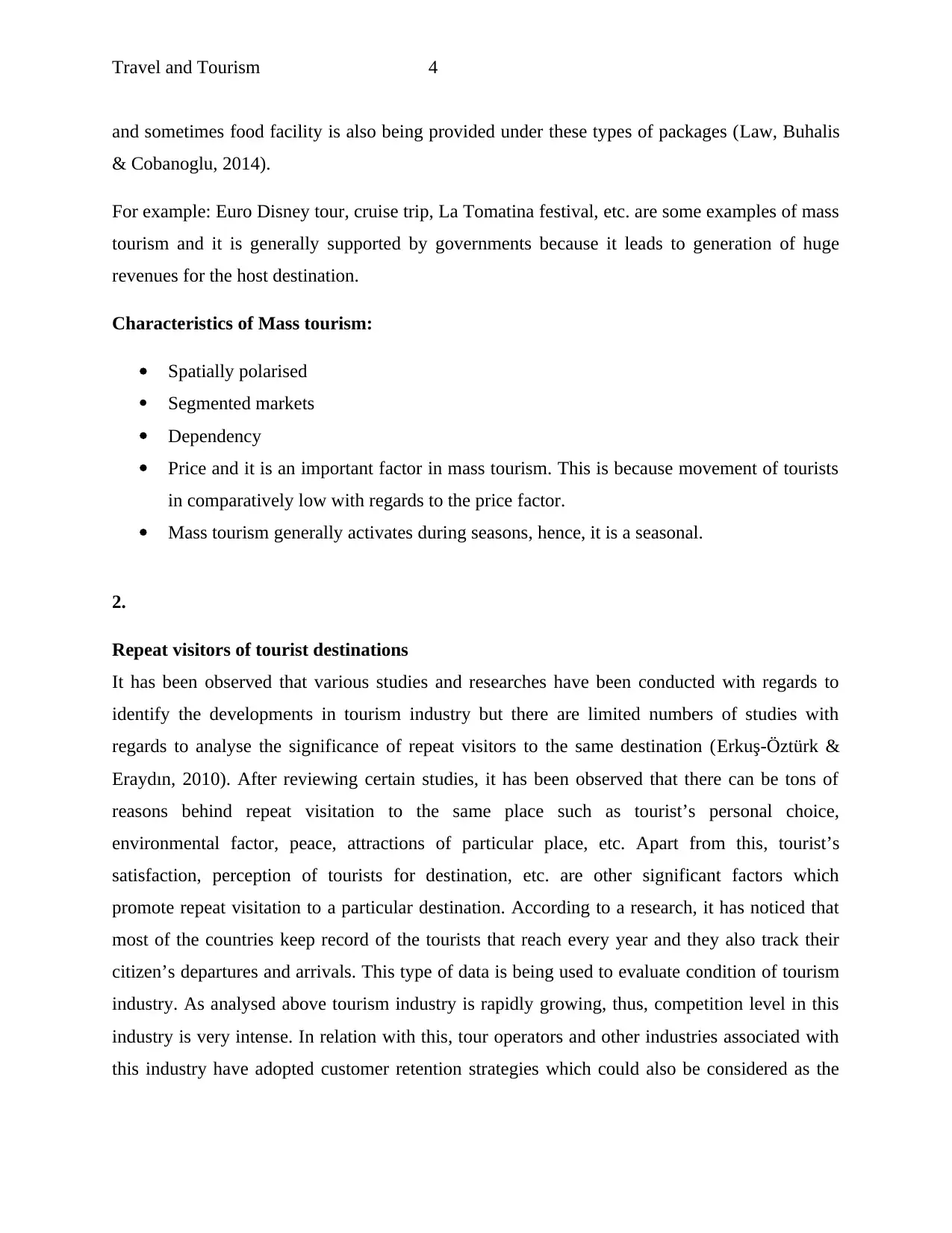
Travel and Tourism 4
and sometimes food facility is also being provided under these types of packages (Law, Buhalis
& Cobanoglu, 2014).
For example: Euro Disney tour, cruise trip, La Tomatina festival, etc. are some examples of mass
tourism and it is generally supported by governments because it leads to generation of huge
revenues for the host destination.
Characteristics of Mass tourism:
Spatially polarised
Segmented markets
Dependency
Price and it is an important factor in mass tourism. This is because movement of tourists
in comparatively low with regards to the price factor.
Mass tourism generally activates during seasons, hence, it is a seasonal.
2.
Repeat visitors of tourist destinations
It has been observed that various studies and researches have been conducted with regards to
identify the developments in tourism industry but there are limited numbers of studies with
regards to analyse the significance of repeat visitors to the same destination (Erkuş-Öztürk &
Eraydın, 2010). After reviewing certain studies, it has been observed that there can be tons of
reasons behind repeat visitation to the same place such as tourist’s personal choice,
environmental factor, peace, attractions of particular place, etc. Apart from this, tourist’s
satisfaction, perception of tourists for destination, etc. are other significant factors which
promote repeat visitation to a particular destination. According to a research, it has noticed that
most of the countries keep record of the tourists that reach every year and they also track their
citizen’s departures and arrivals. This type of data is being used to evaluate condition of tourism
industry. As analysed above tourism industry is rapidly growing, thus, competition level in this
industry is very intense. In relation with this, tour operators and other industries associated with
this industry have adopted customer retention strategies which could also be considered as the
and sometimes food facility is also being provided under these types of packages (Law, Buhalis
& Cobanoglu, 2014).
For example: Euro Disney tour, cruise trip, La Tomatina festival, etc. are some examples of mass
tourism and it is generally supported by governments because it leads to generation of huge
revenues for the host destination.
Characteristics of Mass tourism:
Spatially polarised
Segmented markets
Dependency
Price and it is an important factor in mass tourism. This is because movement of tourists
in comparatively low with regards to the price factor.
Mass tourism generally activates during seasons, hence, it is a seasonal.
2.
Repeat visitors of tourist destinations
It has been observed that various studies and researches have been conducted with regards to
identify the developments in tourism industry but there are limited numbers of studies with
regards to analyse the significance of repeat visitors to the same destination (Erkuş-Öztürk &
Eraydın, 2010). After reviewing certain studies, it has been observed that there can be tons of
reasons behind repeat visitation to the same place such as tourist’s personal choice,
environmental factor, peace, attractions of particular place, etc. Apart from this, tourist’s
satisfaction, perception of tourists for destination, etc. are other significant factors which
promote repeat visitation to a particular destination. According to a research, it has noticed that
most of the countries keep record of the tourists that reach every year and they also track their
citizen’s departures and arrivals. This type of data is being used to evaluate condition of tourism
industry. As analysed above tourism industry is rapidly growing, thus, competition level in this
industry is very intense. In relation with this, tour operators and other industries associated with
this industry have adopted customer retention strategies which could also be considered as the
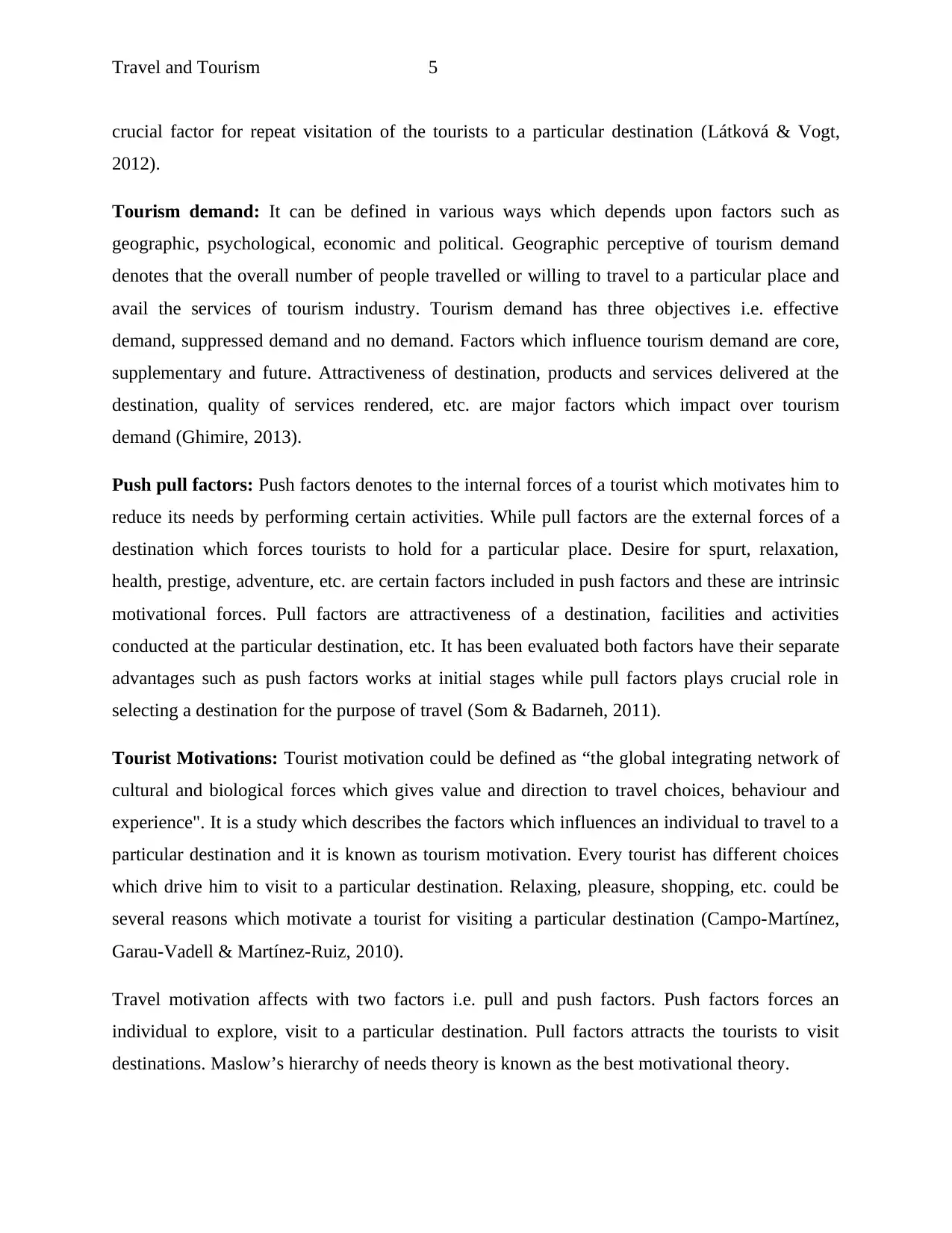
Travel and Tourism 5
crucial factor for repeat visitation of the tourists to a particular destination (Látková & Vogt,
2012).
Tourism demand: It can be defined in various ways which depends upon factors such as
geographic, psychological, economic and political. Geographic perceptive of tourism demand
denotes that the overall number of people travelled or willing to travel to a particular place and
avail the services of tourism industry. Tourism demand has three objectives i.e. effective
demand, suppressed demand and no demand. Factors which influence tourism demand are core,
supplementary and future. Attractiveness of destination, products and services delivered at the
destination, quality of services rendered, etc. are major factors which impact over tourism
demand (Ghimire, 2013).
Push pull factors: Push factors denotes to the internal forces of a tourist which motivates him to
reduce its needs by performing certain activities. While pull factors are the external forces of a
destination which forces tourists to hold for a particular place. Desire for spurt, relaxation,
health, prestige, adventure, etc. are certain factors included in push factors and these are intrinsic
motivational forces. Pull factors are attractiveness of a destination, facilities and activities
conducted at the particular destination, etc. It has been evaluated both factors have their separate
advantages such as push factors works at initial stages while pull factors plays crucial role in
selecting a destination for the purpose of travel (Som & Badarneh, 2011).
Tourist Motivations: Tourist motivation could be defined as “the global integrating network of
cultural and biological forces which gives value and direction to travel choices, behaviour and
experience". It is a study which describes the factors which influences an individual to travel to a
particular destination and it is known as tourism motivation. Every tourist has different choices
which drive him to visit to a particular destination. Relaxing, pleasure, shopping, etc. could be
several reasons which motivate a tourist for visiting a particular destination (Campo-Martínez,
Garau-Vadell & Martínez-Ruiz, 2010).
Travel motivation affects with two factors i.e. pull and push factors. Push factors forces an
individual to explore, visit to a particular destination. Pull factors attracts the tourists to visit
destinations. Maslow’s hierarchy of needs theory is known as the best motivational theory.
crucial factor for repeat visitation of the tourists to a particular destination (Látková & Vogt,
2012).
Tourism demand: It can be defined in various ways which depends upon factors such as
geographic, psychological, economic and political. Geographic perceptive of tourism demand
denotes that the overall number of people travelled or willing to travel to a particular place and
avail the services of tourism industry. Tourism demand has three objectives i.e. effective
demand, suppressed demand and no demand. Factors which influence tourism demand are core,
supplementary and future. Attractiveness of destination, products and services delivered at the
destination, quality of services rendered, etc. are major factors which impact over tourism
demand (Ghimire, 2013).
Push pull factors: Push factors denotes to the internal forces of a tourist which motivates him to
reduce its needs by performing certain activities. While pull factors are the external forces of a
destination which forces tourists to hold for a particular place. Desire for spurt, relaxation,
health, prestige, adventure, etc. are certain factors included in push factors and these are intrinsic
motivational forces. Pull factors are attractiveness of a destination, facilities and activities
conducted at the particular destination, etc. It has been evaluated both factors have their separate
advantages such as push factors works at initial stages while pull factors plays crucial role in
selecting a destination for the purpose of travel (Som & Badarneh, 2011).
Tourist Motivations: Tourist motivation could be defined as “the global integrating network of
cultural and biological forces which gives value and direction to travel choices, behaviour and
experience". It is a study which describes the factors which influences an individual to travel to a
particular destination and it is known as tourism motivation. Every tourist has different choices
which drive him to visit to a particular destination. Relaxing, pleasure, shopping, etc. could be
several reasons which motivate a tourist for visiting a particular destination (Campo-Martínez,
Garau-Vadell & Martínez-Ruiz, 2010).
Travel motivation affects with two factors i.e. pull and push factors. Push factors forces an
individual to explore, visit to a particular destination. Pull factors attracts the tourists to visit
destinations. Maslow’s hierarchy of needs theory is known as the best motivational theory.
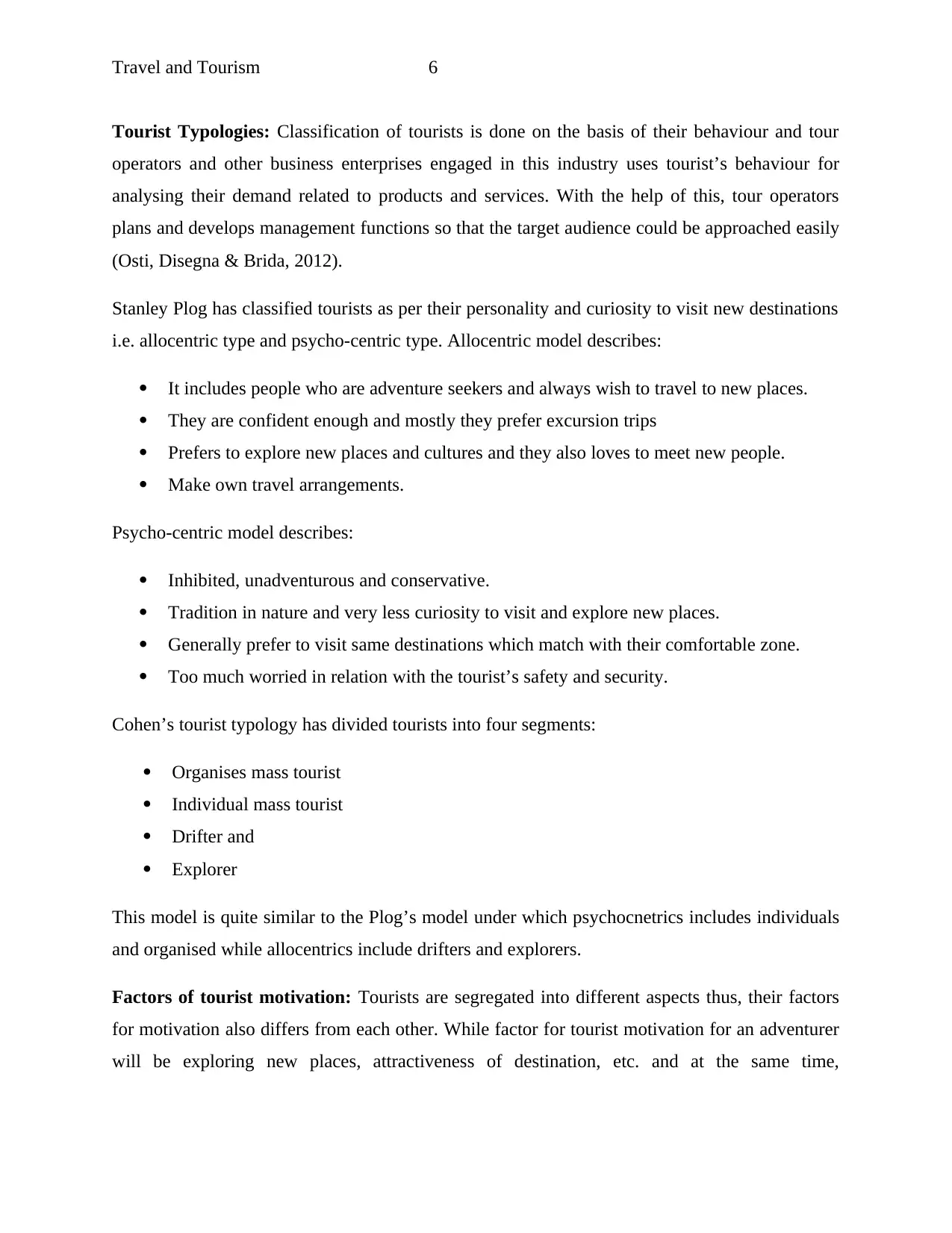
Travel and Tourism 6
Tourist Typologies: Classification of tourists is done on the basis of their behaviour and tour
operators and other business enterprises engaged in this industry uses tourist’s behaviour for
analysing their demand related to products and services. With the help of this, tour operators
plans and develops management functions so that the target audience could be approached easily
(Osti, Disegna & Brida, 2012).
Stanley Plog has classified tourists as per their personality and curiosity to visit new destinations
i.e. allocentric type and psycho-centric type. Allocentric model describes:
It includes people who are adventure seekers and always wish to travel to new places.
They are confident enough and mostly they prefer excursion trips
Prefers to explore new places and cultures and they also loves to meet new people.
Make own travel arrangements.
Psycho-centric model describes:
Inhibited, unadventurous and conservative.
Tradition in nature and very less curiosity to visit and explore new places.
Generally prefer to visit same destinations which match with their comfortable zone.
Too much worried in relation with the tourist’s safety and security.
Cohen’s tourist typology has divided tourists into four segments:
Organises mass tourist
Individual mass tourist
Drifter and
Explorer
This model is quite similar to the Plog’s model under which psychocnetrics includes individuals
and organised while allocentrics include drifters and explorers.
Factors of tourist motivation: Tourists are segregated into different aspects thus, their factors
for motivation also differs from each other. While factor for tourist motivation for an adventurer
will be exploring new places, attractiveness of destination, etc. and at the same time,
Tourist Typologies: Classification of tourists is done on the basis of their behaviour and tour
operators and other business enterprises engaged in this industry uses tourist’s behaviour for
analysing their demand related to products and services. With the help of this, tour operators
plans and develops management functions so that the target audience could be approached easily
(Osti, Disegna & Brida, 2012).
Stanley Plog has classified tourists as per their personality and curiosity to visit new destinations
i.e. allocentric type and psycho-centric type. Allocentric model describes:
It includes people who are adventure seekers and always wish to travel to new places.
They are confident enough and mostly they prefer excursion trips
Prefers to explore new places and cultures and they also loves to meet new people.
Make own travel arrangements.
Psycho-centric model describes:
Inhibited, unadventurous and conservative.
Tradition in nature and very less curiosity to visit and explore new places.
Generally prefer to visit same destinations which match with their comfortable zone.
Too much worried in relation with the tourist’s safety and security.
Cohen’s tourist typology has divided tourists into four segments:
Organises mass tourist
Individual mass tourist
Drifter and
Explorer
This model is quite similar to the Plog’s model under which psychocnetrics includes individuals
and organised while allocentrics include drifters and explorers.
Factors of tourist motivation: Tourists are segregated into different aspects thus, their factors
for motivation also differs from each other. While factor for tourist motivation for an adventurer
will be exploring new places, attractiveness of destination, etc. and at the same time,
Paraphrase This Document
Need a fresh take? Get an instant paraphrase of this document with our AI Paraphraser
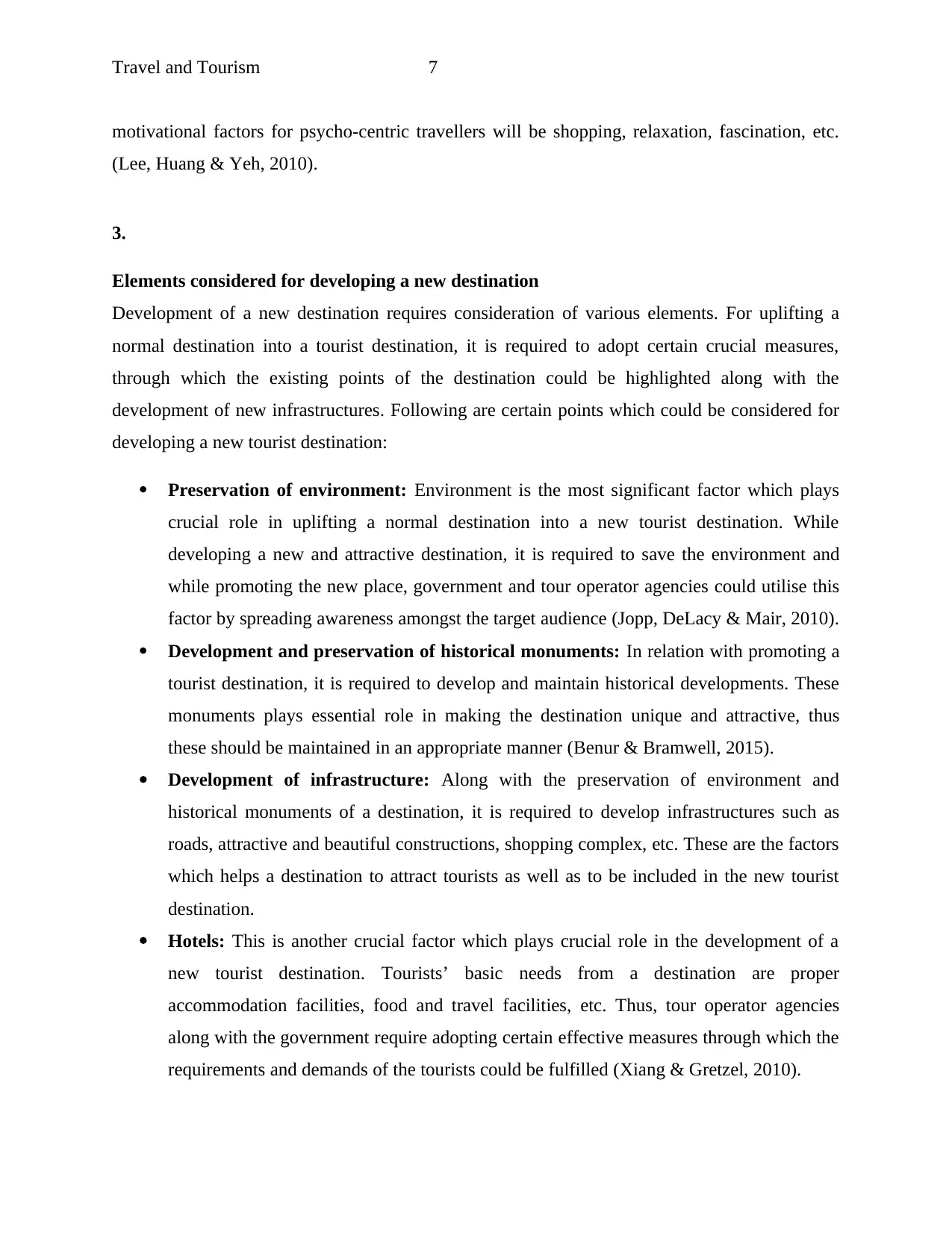
Travel and Tourism 7
motivational factors for psycho-centric travellers will be shopping, relaxation, fascination, etc.
(Lee, Huang & Yeh, 2010).
3.
Elements considered for developing a new destination
Development of a new destination requires consideration of various elements. For uplifting a
normal destination into a tourist destination, it is required to adopt certain crucial measures,
through which the existing points of the destination could be highlighted along with the
development of new infrastructures. Following are certain points which could be considered for
developing a new tourist destination:
Preservation of environment: Environment is the most significant factor which plays
crucial role in uplifting a normal destination into a new tourist destination. While
developing a new and attractive destination, it is required to save the environment and
while promoting the new place, government and tour operator agencies could utilise this
factor by spreading awareness amongst the target audience (Jopp, DeLacy & Mair, 2010).
Development and preservation of historical monuments: In relation with promoting a
tourist destination, it is required to develop and maintain historical developments. These
monuments plays essential role in making the destination unique and attractive, thus
these should be maintained in an appropriate manner (Benur & Bramwell, 2015).
Development of infrastructure: Along with the preservation of environment and
historical monuments of a destination, it is required to develop infrastructures such as
roads, attractive and beautiful constructions, shopping complex, etc. These are the factors
which helps a destination to attract tourists as well as to be included in the new tourist
destination.
Hotels: This is another crucial factor which plays crucial role in the development of a
new tourist destination. Tourists’ basic needs from a destination are proper
accommodation facilities, food and travel facilities, etc. Thus, tour operator agencies
along with the government require adopting certain effective measures through which the
requirements and demands of the tourists could be fulfilled (Xiang & Gretzel, 2010).
motivational factors for psycho-centric travellers will be shopping, relaxation, fascination, etc.
(Lee, Huang & Yeh, 2010).
3.
Elements considered for developing a new destination
Development of a new destination requires consideration of various elements. For uplifting a
normal destination into a tourist destination, it is required to adopt certain crucial measures,
through which the existing points of the destination could be highlighted along with the
development of new infrastructures. Following are certain points which could be considered for
developing a new tourist destination:
Preservation of environment: Environment is the most significant factor which plays
crucial role in uplifting a normal destination into a new tourist destination. While
developing a new and attractive destination, it is required to save the environment and
while promoting the new place, government and tour operator agencies could utilise this
factor by spreading awareness amongst the target audience (Jopp, DeLacy & Mair, 2010).
Development and preservation of historical monuments: In relation with promoting a
tourist destination, it is required to develop and maintain historical developments. These
monuments plays essential role in making the destination unique and attractive, thus
these should be maintained in an appropriate manner (Benur & Bramwell, 2015).
Development of infrastructure: Along with the preservation of environment and
historical monuments of a destination, it is required to develop infrastructures such as
roads, attractive and beautiful constructions, shopping complex, etc. These are the factors
which helps a destination to attract tourists as well as to be included in the new tourist
destination.
Hotels: This is another crucial factor which plays crucial role in the development of a
new tourist destination. Tourists’ basic needs from a destination are proper
accommodation facilities, food and travel facilities, etc. Thus, tour operator agencies
along with the government require adopting certain effective measures through which the
requirements and demands of the tourists could be fulfilled (Xiang & Gretzel, 2010).
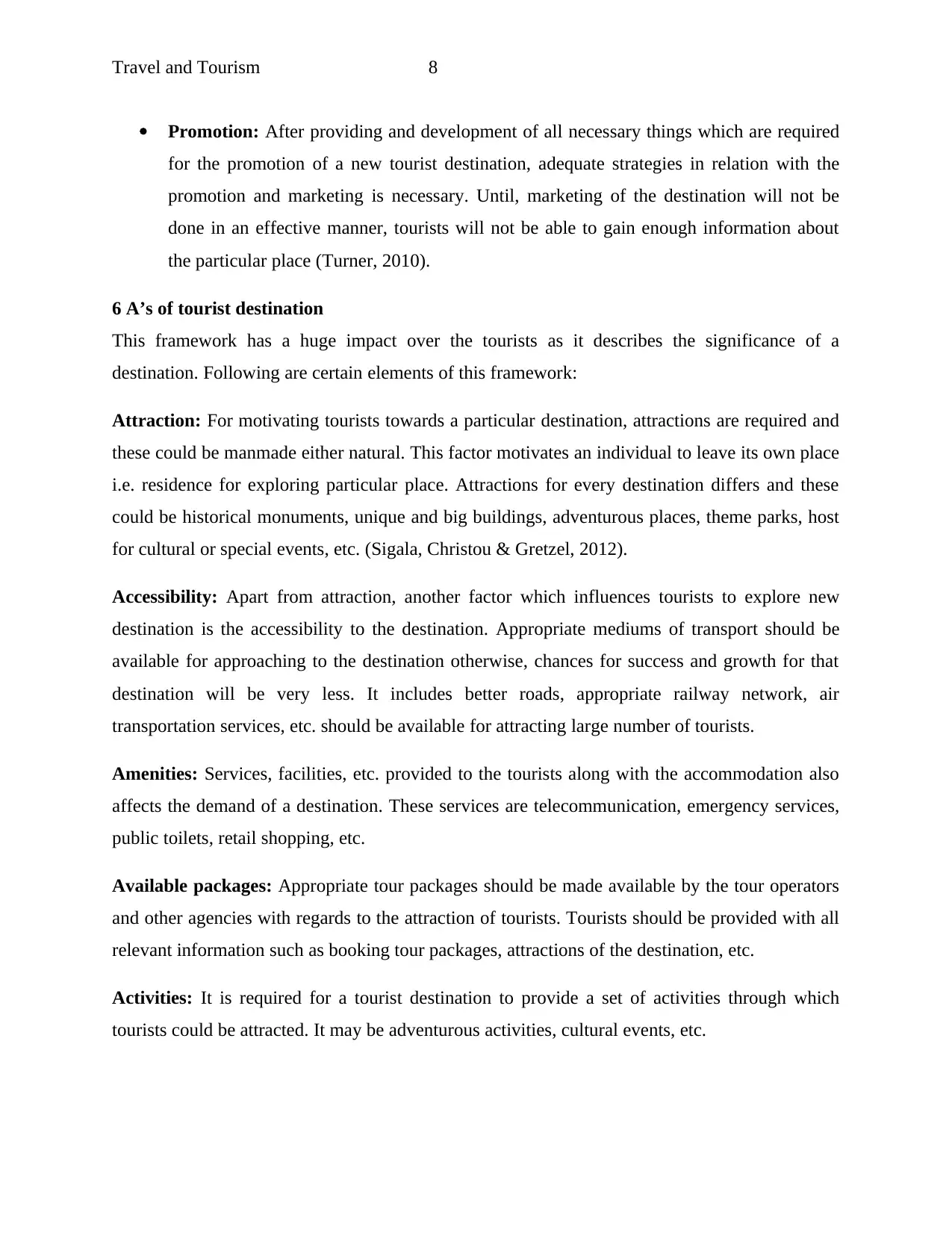
Travel and Tourism 8
Promotion: After providing and development of all necessary things which are required
for the promotion of a new tourist destination, adequate strategies in relation with the
promotion and marketing is necessary. Until, marketing of the destination will not be
done in an effective manner, tourists will not be able to gain enough information about
the particular place (Turner, 2010).
6 A’s of tourist destination
This framework has a huge impact over the tourists as it describes the significance of a
destination. Following are certain elements of this framework:
Attraction: For motivating tourists towards a particular destination, attractions are required and
these could be manmade either natural. This factor motivates an individual to leave its own place
i.e. residence for exploring particular place. Attractions for every destination differs and these
could be historical monuments, unique and big buildings, adventurous places, theme parks, host
for cultural or special events, etc. (Sigala, Christou & Gretzel, 2012).
Accessibility: Apart from attraction, another factor which influences tourists to explore new
destination is the accessibility to the destination. Appropriate mediums of transport should be
available for approaching to the destination otherwise, chances for success and growth for that
destination will be very less. It includes better roads, appropriate railway network, air
transportation services, etc. should be available for attracting large number of tourists.
Amenities: Services, facilities, etc. provided to the tourists along with the accommodation also
affects the demand of a destination. These services are telecommunication, emergency services,
public toilets, retail shopping, etc.
Available packages: Appropriate tour packages should be made available by the tour operators
and other agencies with regards to the attraction of tourists. Tourists should be provided with all
relevant information such as booking tour packages, attractions of the destination, etc.
Activities: It is required for a tourist destination to provide a set of activities through which
tourists could be attracted. It may be adventurous activities, cultural events, etc.
Promotion: After providing and development of all necessary things which are required
for the promotion of a new tourist destination, adequate strategies in relation with the
promotion and marketing is necessary. Until, marketing of the destination will not be
done in an effective manner, tourists will not be able to gain enough information about
the particular place (Turner, 2010).
6 A’s of tourist destination
This framework has a huge impact over the tourists as it describes the significance of a
destination. Following are certain elements of this framework:
Attraction: For motivating tourists towards a particular destination, attractions are required and
these could be manmade either natural. This factor motivates an individual to leave its own place
i.e. residence for exploring particular place. Attractions for every destination differs and these
could be historical monuments, unique and big buildings, adventurous places, theme parks, host
for cultural or special events, etc. (Sigala, Christou & Gretzel, 2012).
Accessibility: Apart from attraction, another factor which influences tourists to explore new
destination is the accessibility to the destination. Appropriate mediums of transport should be
available for approaching to the destination otherwise, chances for success and growth for that
destination will be very less. It includes better roads, appropriate railway network, air
transportation services, etc. should be available for attracting large number of tourists.
Amenities: Services, facilities, etc. provided to the tourists along with the accommodation also
affects the demand of a destination. These services are telecommunication, emergency services,
public toilets, retail shopping, etc.
Available packages: Appropriate tour packages should be made available by the tour operators
and other agencies with regards to the attraction of tourists. Tourists should be provided with all
relevant information such as booking tour packages, attractions of the destination, etc.
Activities: It is required for a tourist destination to provide a set of activities through which
tourists could be attracted. It may be adventurous activities, cultural events, etc.
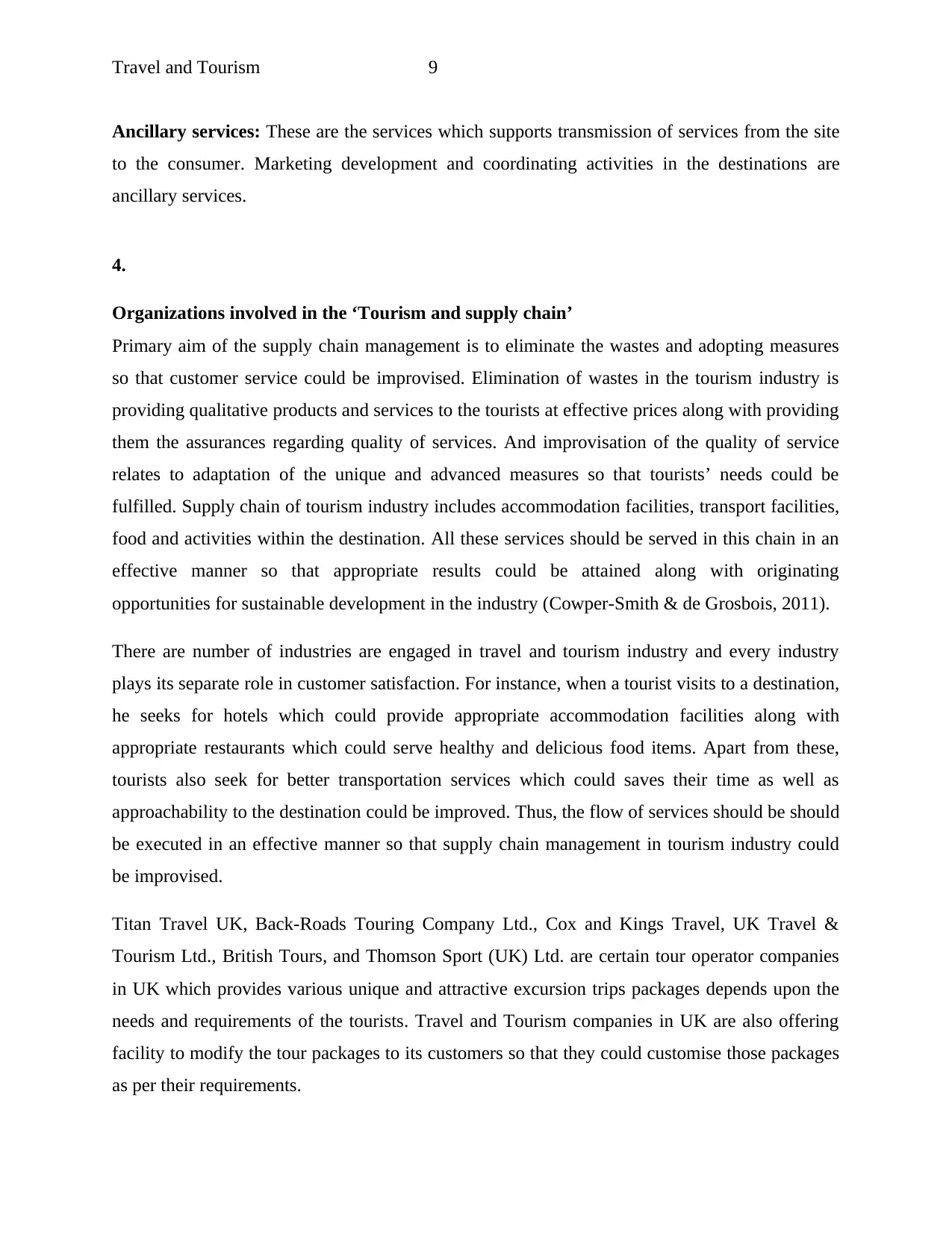
Travel and Tourism 9
Ancillary services: These are the services which supports transmission of services from the site
to the consumer. Marketing development and coordinating activities in the destinations are
ancillary services.
4.
Organizations involved in the ‘Tourism and supply chain’
Primary aim of the supply chain management is to eliminate the wastes and adopting measures
so that customer service could be improvised. Elimination of wastes in the tourism industry is
providing qualitative products and services to the tourists at effective prices along with providing
them the assurances regarding quality of services. And improvisation of the quality of service
relates to adaptation of the unique and advanced measures so that tourists’ needs could be
fulfilled. Supply chain of tourism industry includes accommodation facilities, transport facilities,
food and activities within the destination. All these services should be served in this chain in an
effective manner so that appropriate results could be attained along with originating
opportunities for sustainable development in the industry (Cowper-Smith & de Grosbois, 2011).
There are number of industries are engaged in travel and tourism industry and every industry
plays its separate role in customer satisfaction. For instance, when a tourist visits to a destination,
he seeks for hotels which could provide appropriate accommodation facilities along with
appropriate restaurants which could serve healthy and delicious food items. Apart from these,
tourists also seek for better transportation services which could saves their time as well as
approachability to the destination could be improved. Thus, the flow of services should be should
be executed in an effective manner so that supply chain management in tourism industry could
be improvised.
Titan Travel UK, Back-Roads Touring Company Ltd., Cox and Kings Travel, UK Travel &
Tourism Ltd., British Tours, and Thomson Sport (UK) Ltd. are certain tour operator companies
in UK which provides various unique and attractive excursion trips packages depends upon the
needs and requirements of the tourists. Travel and Tourism companies in UK are also offering
facility to modify the tour packages to its customers so that they could customise those packages
as per their requirements.
Ancillary services: These are the services which supports transmission of services from the site
to the consumer. Marketing development and coordinating activities in the destinations are
ancillary services.
4.
Organizations involved in the ‘Tourism and supply chain’
Primary aim of the supply chain management is to eliminate the wastes and adopting measures
so that customer service could be improvised. Elimination of wastes in the tourism industry is
providing qualitative products and services to the tourists at effective prices along with providing
them the assurances regarding quality of services. And improvisation of the quality of service
relates to adaptation of the unique and advanced measures so that tourists’ needs could be
fulfilled. Supply chain of tourism industry includes accommodation facilities, transport facilities,
food and activities within the destination. All these services should be served in this chain in an
effective manner so that appropriate results could be attained along with originating
opportunities for sustainable development in the industry (Cowper-Smith & de Grosbois, 2011).
There are number of industries are engaged in travel and tourism industry and every industry
plays its separate role in customer satisfaction. For instance, when a tourist visits to a destination,
he seeks for hotels which could provide appropriate accommodation facilities along with
appropriate restaurants which could serve healthy and delicious food items. Apart from these,
tourists also seek for better transportation services which could saves their time as well as
approachability to the destination could be improved. Thus, the flow of services should be should
be executed in an effective manner so that supply chain management in tourism industry could
be improvised.
Titan Travel UK, Back-Roads Touring Company Ltd., Cox and Kings Travel, UK Travel &
Tourism Ltd., British Tours, and Thomson Sport (UK) Ltd. are certain tour operator companies
in UK which provides various unique and attractive excursion trips packages depends upon the
needs and requirements of the tourists. Travel and Tourism companies in UK are also offering
facility to modify the tour packages to its customers so that they could customise those packages
as per their requirements.
Secure Best Marks with AI Grader
Need help grading? Try our AI Grader for instant feedback on your assignments.
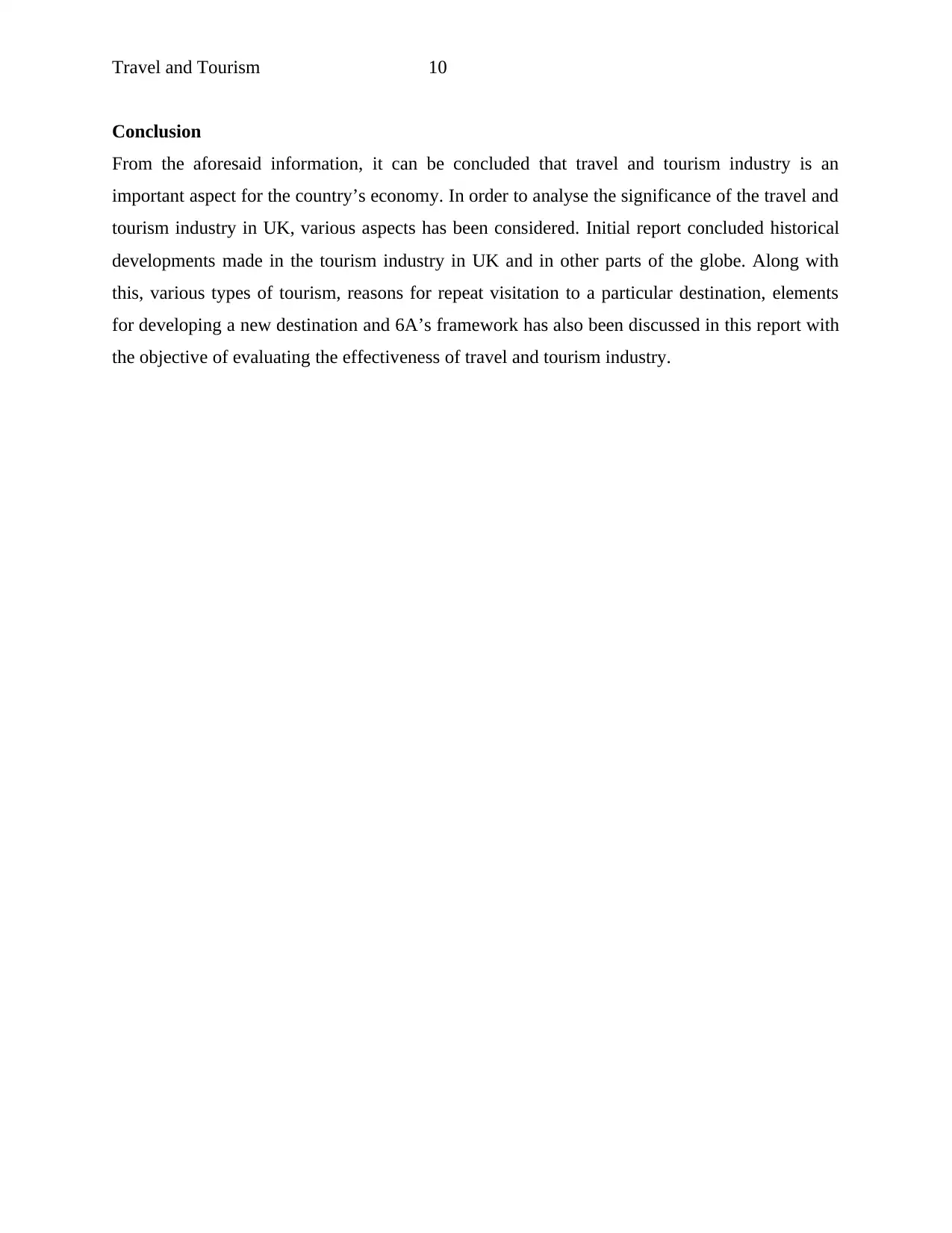
Travel and Tourism 10
Conclusion
From the aforesaid information, it can be concluded that travel and tourism industry is an
important aspect for the country’s economy. In order to analyse the significance of the travel and
tourism industry in UK, various aspects has been considered. Initial report concluded historical
developments made in the tourism industry in UK and in other parts of the globe. Along with
this, various types of tourism, reasons for repeat visitation to a particular destination, elements
for developing a new destination and 6A’s framework has also been discussed in this report with
the objective of evaluating the effectiveness of travel and tourism industry.
Conclusion
From the aforesaid information, it can be concluded that travel and tourism industry is an
important aspect for the country’s economy. In order to analyse the significance of the travel and
tourism industry in UK, various aspects has been considered. Initial report concluded historical
developments made in the tourism industry in UK and in other parts of the globe. Along with
this, various types of tourism, reasons for repeat visitation to a particular destination, elements
for developing a new destination and 6A’s framework has also been discussed in this report with
the objective of evaluating the effectiveness of travel and tourism industry.
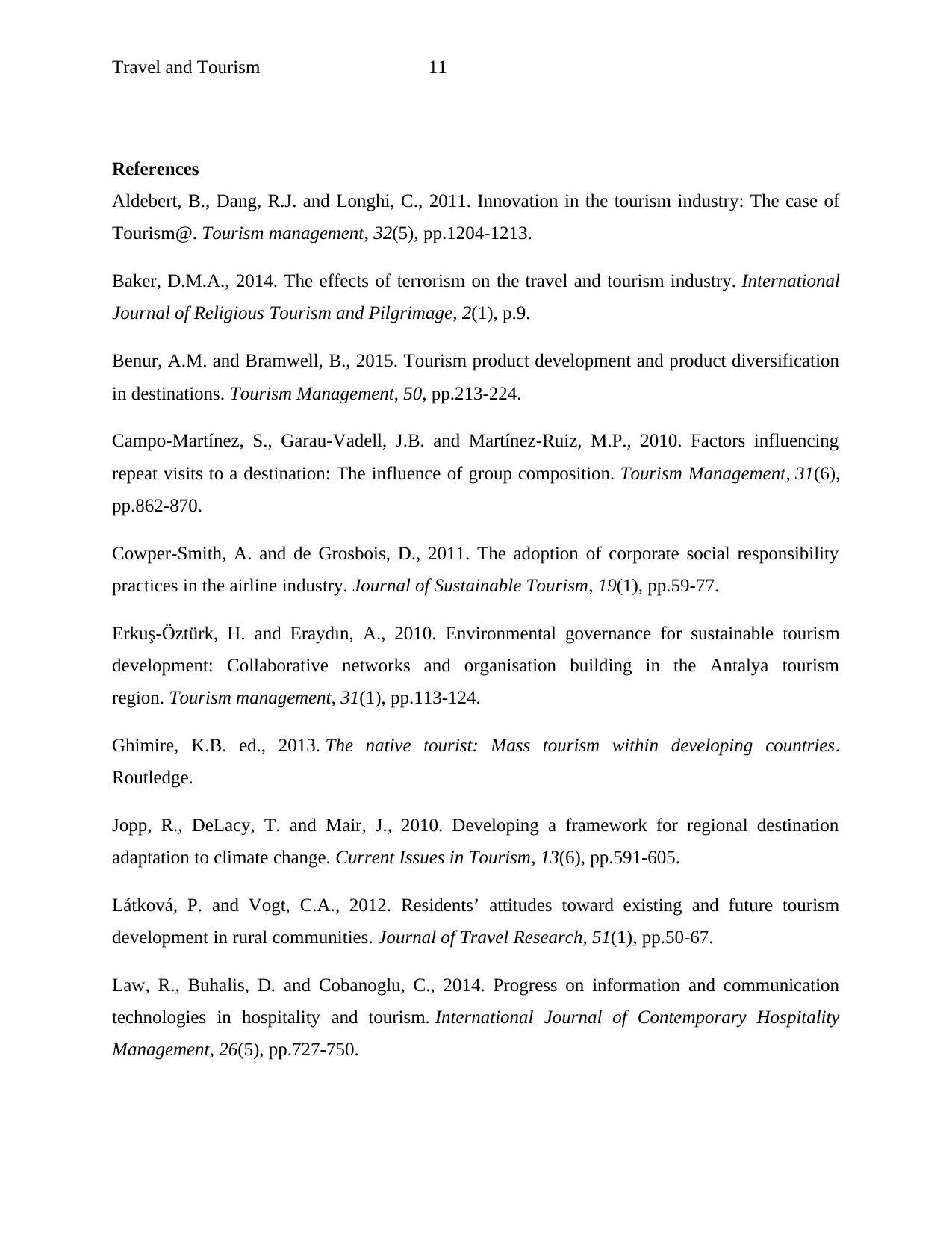
Travel and Tourism 11
References
Aldebert, B., Dang, R.J. and Longhi, C., 2011. Innovation in the tourism industry: The case of
Tourism@. Tourism management, 32(5), pp.1204-1213.
Baker, D.M.A., 2014. The effects of terrorism on the travel and tourism industry. International
Journal of Religious Tourism and Pilgrimage, 2(1), p.9.
Benur, A.M. and Bramwell, B., 2015. Tourism product development and product diversification
in destinations. Tourism Management, 50, pp.213-224.
Campo-Martínez, S., Garau-Vadell, J.B. and Martínez-Ruiz, M.P., 2010. Factors influencing
repeat visits to a destination: The influence of group composition. Tourism Management, 31(6),
pp.862-870.
Cowper-Smith, A. and de Grosbois, D., 2011. The adoption of corporate social responsibility
practices in the airline industry. Journal of Sustainable Tourism, 19(1), pp.59-77.
Erkuş-Öztürk, H. and Eraydın, A., 2010. Environmental governance for sustainable tourism
development: Collaborative networks and organisation building in the Antalya tourism
region. Tourism management, 31(1), pp.113-124.
Ghimire, K.B. ed., 2013. The native tourist: Mass tourism within developing countries.
Routledge.
Jopp, R., DeLacy, T. and Mair, J., 2010. Developing a framework for regional destination
adaptation to climate change. Current Issues in Tourism, 13(6), pp.591-605.
Látková, P. and Vogt, C.A., 2012. Residents’ attitudes toward existing and future tourism
development in rural communities. Journal of Travel Research, 51(1), pp.50-67.
Law, R., Buhalis, D. and Cobanoglu, C., 2014. Progress on information and communication
technologies in hospitality and tourism. International Journal of Contemporary Hospitality
Management, 26(5), pp.727-750.
References
Aldebert, B., Dang, R.J. and Longhi, C., 2011. Innovation in the tourism industry: The case of
Tourism@. Tourism management, 32(5), pp.1204-1213.
Baker, D.M.A., 2014. The effects of terrorism on the travel and tourism industry. International
Journal of Religious Tourism and Pilgrimage, 2(1), p.9.
Benur, A.M. and Bramwell, B., 2015. Tourism product development and product diversification
in destinations. Tourism Management, 50, pp.213-224.
Campo-Martínez, S., Garau-Vadell, J.B. and Martínez-Ruiz, M.P., 2010. Factors influencing
repeat visits to a destination: The influence of group composition. Tourism Management, 31(6),
pp.862-870.
Cowper-Smith, A. and de Grosbois, D., 2011. The adoption of corporate social responsibility
practices in the airline industry. Journal of Sustainable Tourism, 19(1), pp.59-77.
Erkuş-Öztürk, H. and Eraydın, A., 2010. Environmental governance for sustainable tourism
development: Collaborative networks and organisation building in the Antalya tourism
region. Tourism management, 31(1), pp.113-124.
Ghimire, K.B. ed., 2013. The native tourist: Mass tourism within developing countries.
Routledge.
Jopp, R., DeLacy, T. and Mair, J., 2010. Developing a framework for regional destination
adaptation to climate change. Current Issues in Tourism, 13(6), pp.591-605.
Látková, P. and Vogt, C.A., 2012. Residents’ attitudes toward existing and future tourism
development in rural communities. Journal of Travel Research, 51(1), pp.50-67.
Law, R., Buhalis, D. and Cobanoglu, C., 2014. Progress on information and communication
technologies in hospitality and tourism. International Journal of Contemporary Hospitality
Management, 26(5), pp.727-750.
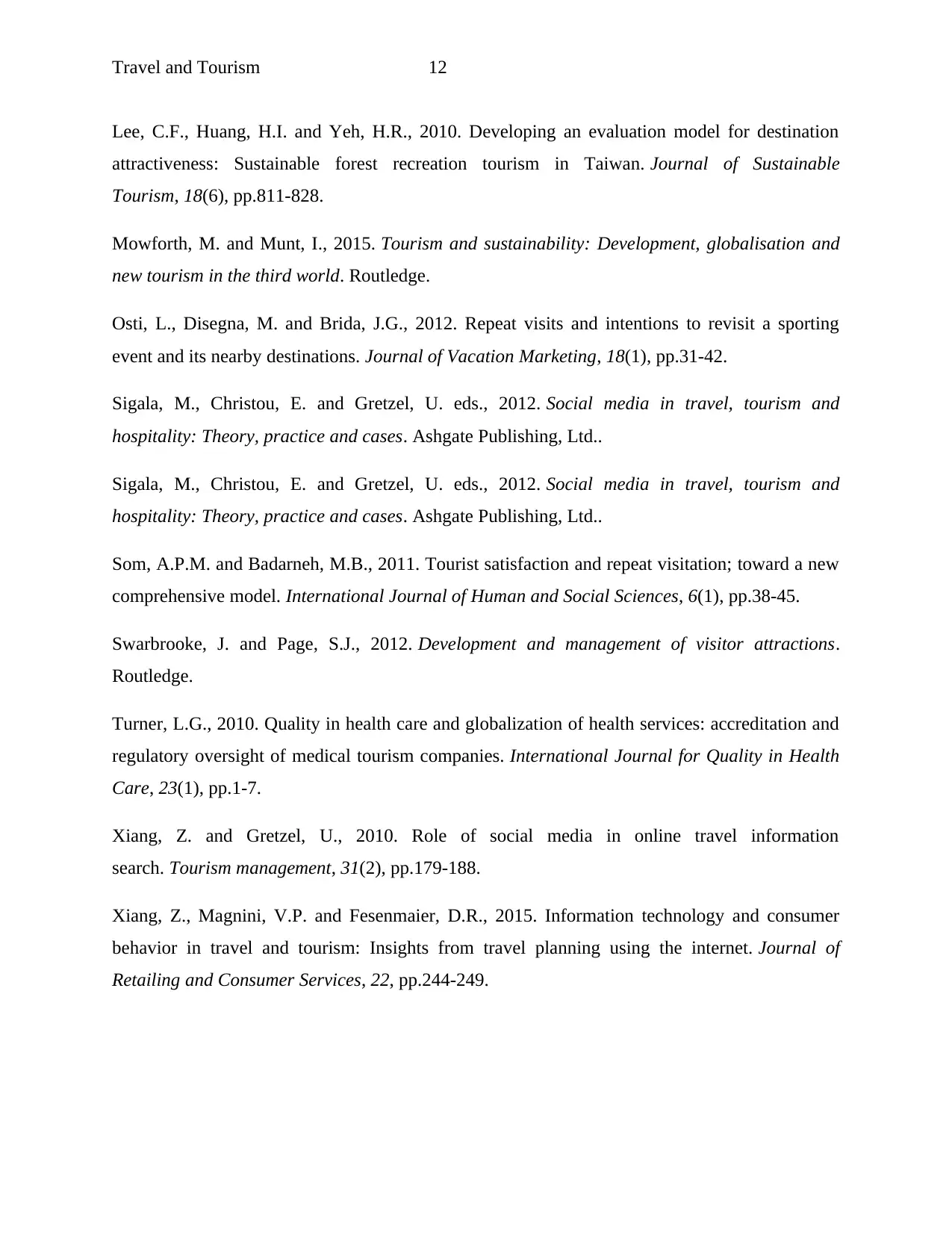
Travel and Tourism 12
Lee, C.F., Huang, H.I. and Yeh, H.R., 2010. Developing an evaluation model for destination
attractiveness: Sustainable forest recreation tourism in Taiwan. Journal of Sustainable
Tourism, 18(6), pp.811-828.
Mowforth, M. and Munt, I., 2015. Tourism and sustainability: Development, globalisation and
new tourism in the third world. Routledge.
Osti, L., Disegna, M. and Brida, J.G., 2012. Repeat visits and intentions to revisit a sporting
event and its nearby destinations. Journal of Vacation Marketing, 18(1), pp.31-42.
Sigala, M., Christou, E. and Gretzel, U. eds., 2012. Social media in travel, tourism and
hospitality: Theory, practice and cases. Ashgate Publishing, Ltd..
Sigala, M., Christou, E. and Gretzel, U. eds., 2012. Social media in travel, tourism and
hospitality: Theory, practice and cases. Ashgate Publishing, Ltd..
Som, A.P.M. and Badarneh, M.B., 2011. Tourist satisfaction and repeat visitation; toward a new
comprehensive model. International Journal of Human and Social Sciences, 6(1), pp.38-45.
Swarbrooke, J. and Page, S.J., 2012. Development and management of visitor attractions.
Routledge.
Turner, L.G., 2010. Quality in health care and globalization of health services: accreditation and
regulatory oversight of medical tourism companies. International Journal for Quality in Health
Care, 23(1), pp.1-7.
Xiang, Z. and Gretzel, U., 2010. Role of social media in online travel information
search. Tourism management, 31(2), pp.179-188.
Xiang, Z., Magnini, V.P. and Fesenmaier, D.R., 2015. Information technology and consumer
behavior in travel and tourism: Insights from travel planning using the internet. Journal of
Retailing and Consumer Services, 22, pp.244-249.
Lee, C.F., Huang, H.I. and Yeh, H.R., 2010. Developing an evaluation model for destination
attractiveness: Sustainable forest recreation tourism in Taiwan. Journal of Sustainable
Tourism, 18(6), pp.811-828.
Mowforth, M. and Munt, I., 2015. Tourism and sustainability: Development, globalisation and
new tourism in the third world. Routledge.
Osti, L., Disegna, M. and Brida, J.G., 2012. Repeat visits and intentions to revisit a sporting
event and its nearby destinations. Journal of Vacation Marketing, 18(1), pp.31-42.
Sigala, M., Christou, E. and Gretzel, U. eds., 2012. Social media in travel, tourism and
hospitality: Theory, practice and cases. Ashgate Publishing, Ltd..
Sigala, M., Christou, E. and Gretzel, U. eds., 2012. Social media in travel, tourism and
hospitality: Theory, practice and cases. Ashgate Publishing, Ltd..
Som, A.P.M. and Badarneh, M.B., 2011. Tourist satisfaction and repeat visitation; toward a new
comprehensive model. International Journal of Human and Social Sciences, 6(1), pp.38-45.
Swarbrooke, J. and Page, S.J., 2012. Development and management of visitor attractions.
Routledge.
Turner, L.G., 2010. Quality in health care and globalization of health services: accreditation and
regulatory oversight of medical tourism companies. International Journal for Quality in Health
Care, 23(1), pp.1-7.
Xiang, Z. and Gretzel, U., 2010. Role of social media in online travel information
search. Tourism management, 31(2), pp.179-188.
Xiang, Z., Magnini, V.P. and Fesenmaier, D.R., 2015. Information technology and consumer
behavior in travel and tourism: Insights from travel planning using the internet. Journal of
Retailing and Consumer Services, 22, pp.244-249.
1 out of 13
Related Documents
Your All-in-One AI-Powered Toolkit for Academic Success.
+13062052269
info@desklib.com
Available 24*7 on WhatsApp / Email
![[object Object]](/_next/static/media/star-bottom.7253800d.svg)
Unlock your academic potential
© 2024 | Zucol Services PVT LTD | All rights reserved.





